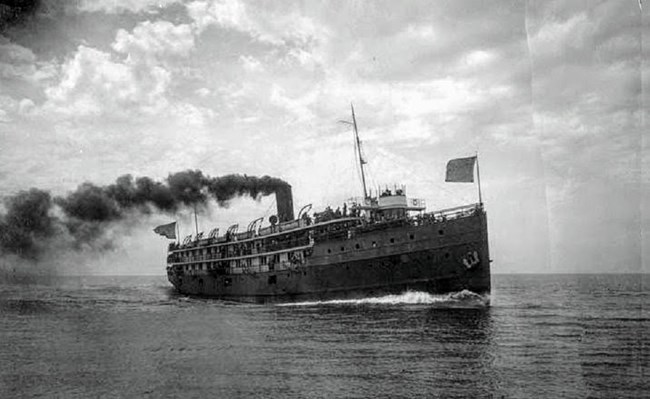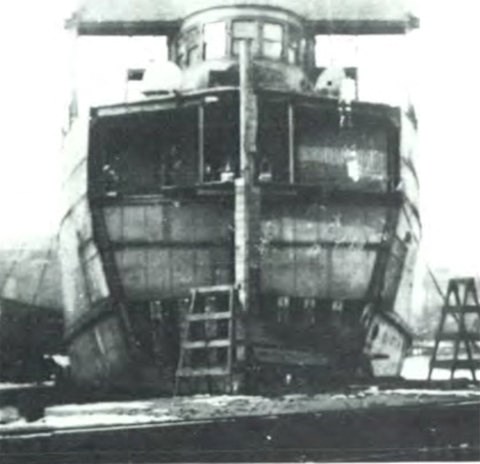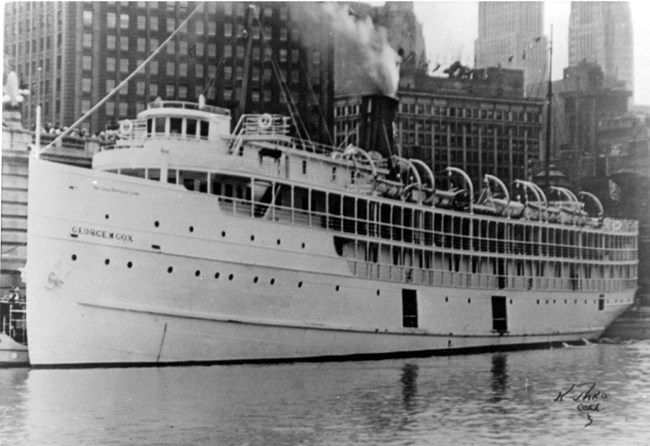Last updated: September 21, 2020
Article
SS George M. Cox: Operational History

U.S. Naval History and Heritage Command, U.S. Navy
Operational History
Graham and Morton Co. was anxious for the delivery of the new vessel. When Puritan left Toledo for Chicago on June 15, carpenters were on board completing their work. The ship was placed on the daily Chicago-to-Holland run shortly after the company took title on June 28, 1901. Typically, Puritan remained on this run until the end of the fruit season, when it sometimes ran from Chicago to Benton Harbor during the winter (Hamilton, n.d.).
Puritan was reboilered in 1905. The Roberts boilers were replaced with four newer 11x10-foot Scotch boilers built by Johnston Bros. of Ferrysburg, Michigan (Hamilton, n.d.). Recent field observations of these boilers reveal they were constructed with steam drums, an unusual feature for Great Lakes vessels.

Lake Superior Marine Museum
Passenger steamers were principally used to bring U.S. troops back home after the Armistice (U.S. Department of the Navy, 1970:5:405). Puritan was modified for naval service at the Krafts Shipyard in South Chicago, where it was fitted out for ocean service and camouflaged.
Most Lakes passenger vessels had to be structurally altered to allow passage to the ocean. Contemporary photographs indicate the bow of Puritan was severed to allow passage through the canal system to the Atlantic. The cut was made immediately forward of the pilothouse, and both sections were apparently bulkheaded to make the passage, or perhaps the smaller bow portion was simply loaded and carried through the passage.

Kenneth E. Thro Collection
After Puritan was decommissioned, it was sold to a private company and rebuilt to resume the Lake passenger trade. The newly rebuilt passenger steamer was chartered to the Michigan Transit Co. of Chicago, which purchased the vessel outright in May, 1924 ("Consolidated Certificate of Enrollment and License." Puritan. May 23, 1924).
In the severe storm of December 6, 7 and 8, 1927, Puritan broke from its moorings in Muskegon Harbor and drifted around with no one aboard. Buffeted by 65-mile-per-hour winds, Puritan dragged its winter moorings - steel cables fixed to large concrete blocks that had been buried 6 feet deep - and came to rest against an abandoned pier at East Lake. The huge concrete blocks that were dragged by the ship prevented serious damage to the hull when the ship hit the pier (Detroit Free Press December 9, 1927). The same storm sank the canaller Kamloops on Isle Royale.
The resort and passenger cruise vessel PURITAN was idled in 1929, just before the demand for recreation cruises and passage to the northern Michigan resorts was virtually eliminated by the Great Depression. The ship was docked at Manistee (Hamilton n.d.).
After the idle time at Manistee, Puritan was purchased by Isle Royale Transportation Co. The Enrollment Document for the purchase (May 22, 1933) registered the name change from Puritan to George M. Cox. The Isle Royale Transportation Co. was an Arizona corporation headed by the man for which Puritan had been renamed.
George M. Cox was a millionaire ship builder and brewer from New Orleans, and a large stockholder of the Duke Transportation Company. The new owner had refitted PURITAN in a grand manner.
There was much excitement regarding the newly appointed George M. Cox. On May 23, the ship, decorated with a new coat of white paint and carrying the International Code of Signals, left the moorings at Arthur Street in Manistee to move down to the Michigan Transit docks. Hundreds of people visited the ship as it lay at the dock, the crew finishing last-minute preparations for departure on Cox's first voyage in more than two years. The ship was slated to leave for Chicago the next morning with George Johnson as captain and Arthur Cronk (appears as Kronk in most other references) of Houghton or Hancock, Michigan, as first mate. The refurbished vessel met with approval from its many visitors and well-wishers. "Entirely repainted, inside and out, the fine appearance of the ship won the favorable comment of those who inspected it" (Manistee News Advocate, May 24, 1933).
